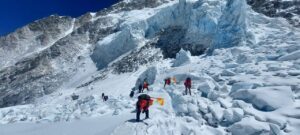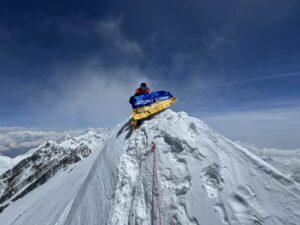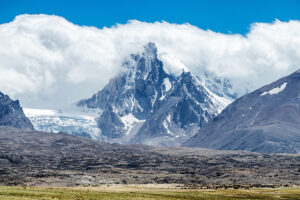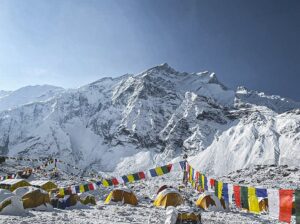Mass-market 8,000m climbing has come to the Himalaya to stay. What are we to make of this new trend?
On April 16, Annapurna saw a record 68 summiters just two weeks after they landed at Base Camp. This, on the most dangerous of all 8,000m peaks. Everyone was elated, except the climbing community.
“This is not alpinism,” many said. The endless lines of climbers snaking to the summit killed the moment for many mountaineers. Virtually everyone was on oxygen. Three out of the few who climbed without it (three Russians and one Taiwanese), needed rescue on their way down.
In addition, the huge team depended entirely on fixed ropes. The outfitters failed to bring enough rope, so at 7,400m, everyone had to follow the Sherpa workers back to Camp 4.
A few years ago, that would have ended the summit attempt. This time, the organizers solved the problem by keeping their clients in Camp 4 overnight and tasking a helicopter to bring ropes and oxygen to their camp at nearly 7,000m.

Uta Ibrahini of Kosovo on the summit of Annapurna. Photo: Uta Ibrahini
Indeed, this is not the alpinism we grew up with. “If only Lachenal [the first Annapurna summiter, in 1950] was here to see!” complained Marc Batard, also on the mountain but not part of the massive summit bid.
Louis Lachenal was a model alpinist from the age of the “mountain conquerors”. He gave everything to reach the untouched summit of Annapurna, including his fingers and toes. He accepted that this was a true adventure and that sometimes the cost is high. By comparison, the 2021 motive was not a quest to write Himalayan history, but a carefully planned business venture where adventure is exactly what they try to avoid.
Mass 8,000m climbing
Winter K2 tested a new model that had already matured just two months later on Annapurna. Elements of the strategy had been in use for some time, but not this methodically. The idea is to get the most climbers to the top as quickly as possible, enlisting all available resources. Seven Summit Treks (SST) was the biggest outfitter and the leader of both expeditions, although seven companies had a presence in Annapurna Base Camp. SST’s polished business model involves a considerable risk but a good possibility of many more summits than its rivals previously dreamed of. This mass approach generates huge profits.
SST knows what their consumers want: attractive goals to sell to sponsors and fans, a solution to technical difficulties, enhanced safety, and maximal summit possibilities. All that, at the lowest possible price.
To achieve this, one can’t be picky about the methods. The strategy doesn’t take a miracle, just hard work, a huge Sherpa staff, kilometres of rope, and enough oxygen to colonize Mars.
None of this is illegal, and those wishing to keep faithful to the alpine-style school may choose a different operation, or none at all, to support their logistics.

The multicolored line to the summit. Photo: Waldemar Kowalewski
Winter K2 threw more shadow than light on SST’s business model, but with Annapurna, they hit the jackpot.
To begin with, they sold many climbers as a double-header, paired with Dhaulagiri. This was very attractive for 14×8,000m wannabes, and the promised speed appealed to those who wanted to climb an 8,000m mountain without investing three months in the project.
To save time, they flew clients from Pokhara, using their own helicopter company. Rather than an extra expense, the brief flight cut days of guiding and porter costs, and servicing climbers during the trek. Annapurna Base Camp is relatively low compared to other 8,000m BCs, which helped the mostly unacclimatized clients.
All outfitters agreed in advance to share the resources (material and human) needed for rope-fixing, to minimize costs. After all, everybody was going to follow the same line of ropes: No one planned an independent ascent via some other route.

Gorgeous weather on Annapurna. Photo: Lakpa Dendi Sherpa
A risky business
Even with all these resources, the weather always dictates the pace. On this extraordinarily dry year, progress was so fast that there was no time for the Sherpa rope-fixers to climb a day or two ahead of the clients. Everyone ended up together on a massive summit push without knowing what the final sections were like. Luckily, both weather and conditions were good enough.
On the other hand, the outfitters minimized risk by fixing every steep or scary spot where climbers might hesitate. This way, everyone could hurry up the exposed parts, as Mingma Dorchi of Pioneer Adventures explained to ExplorersWeb. That was one reason why they ran out of rope. However, they simply solved that problem with a swift helicopter drop. Air support has become key on today’s commercial expeditions.
Most of all, success deleted all possible objections from the clients: the long days at altitude, the unstable weather, the lack of leadership on the mountain, and the real peril that the climbers faced at times: Annapurna’s death rate is 32 percent. But no one died this time, so smiley Instagram shots from the summit and parties in Pokhara will dominate their memories.

After-summit party in Pokhara. Photo: Maya Sherpa
A few climbers on the mountain assessed the situation differently. They criticized the strategy as dangerous and environmentally harmful. However, since they were the ones who didn’t summit, their bitter comments bore less objective weight.
Lu Chung Han of Taiwan, after summiting without oxygen, had superficial frostbite on two toes. He decided that he did not want to slowly cross the dangerous section between Camp 3 and Camp 2 during the descent. So Lu asked for a helicopter lift, his home team told ExplorersWeb. After this “rescue”, he recovered in Kathmandu for a few days. He has now flown to Dhaulagiri with others who signed on for this double-header special, including many of the working Sherpas.

Dhaulagiri rises above the clouds, as seen from Annapurna. Photo: Lakpa Dendi Sherpa
The delay while Sherpa teams moved from Annapurna to Dhaulagiri is likely why no one had yet fixed ropes by the time the first climbers reached Dhaulagiri Base Camp. Stefi Troguet, Jonatan Larrañaga, Carla Perez, and Topo Mena climbed to Camp 2 last week and did not see a single fixed rope. Some days later, Carlos Soria said that Sherpas working for Seven Summit Treks had fixed the route to just above Camp 2.
The SWOT analysis of the 8,000m market
Nowadays, a business tool called the SWOT diagram charts the Strengths, Weaknesses, Opportunities, and Threats of an enterprise. Clearly, the Annapurna 2021 model has several points in the Strengths section. Opportunities abound too, thanks to social media and globalization, which allow local Nepali companies to service climbers from around the world. In fact, they are especially convenient for climbers from countries without a mountaineering tradition. Many try to be the first in their country to climb some or all the 8,000’ers.
As for Weaknesses, we are all comparatively weak in the mountains. Technology or not, weather and mountain conditions can stymie us. A mountain can change abruptly and dramatically. And thus, the greatest Threat in this model: When something doesn’t go as planned, the results can be catastrophic.
With climbers at a maximum and resources at a minimum, everything must go right. The failure of one element in the chain may collapse the whole edifice.

Helicopter longline rescue at Annapurna. Photo: Waldemar Kowalewski
On Annapurna, avalanches often fell while the climbers were there. Luckily, no one was injured. But no one could guarantee that those heading to Camp 3 would not perish along the way.
Temperatures were colder than expected during the summit push, and snow fell intermittently the day before. Still, the helicopter had been able to fly in ropes and especially oxygen, which was running short, to Camp 4. If the weather had grounded the helicopter, climbers could easily panic.
Finally, a more subtle threat lingers at the edge of this model: too much success. All goes so well that more and more climbers flock to the high mountains, which get more and more crowded until the challenge becomes almost banal. Sponsors look other way, audiences get bored or angry at the pitiful show of climbers queuing, questions arise about the environmental damage and the conditions of people working for low-cost companies. Meanwhile, other companies try to horn in on the action, creating market saturation.
Where is this going?
In many ways, the future of commercial, or rather, industrial Himalayism is not very bright. But who can say it’s wrong? Local entrepreneurs just offer a product based on the natural riches of their country. As long as they are clear about what they are offering (which is open for debate), they are simply running a business.
For them, the limitless use of personnel, helicopters, and oxygen is not a problem, just a sign of the times. Free from the influence of the classical values of mountaineering, they embrace progress, technology, and business success. They might also argue that the old European Alps are not exactly pure either, with ropes and ladders and mountain huts and ski resorts everywhere. It’s their turn, now.
Like it or not, the model works, and there is no reason to think that it will change soon. Fatalities may force changes or improvements along the way. Perhaps eventually, clients themselves may decide they want something different and be willing to pay for it.






